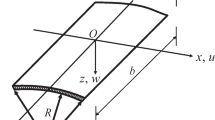Abstract
For the problem of torsion superimposed on extension of incompressible nonlinearly elastic transversely isotropic circular cylinders, a simple asymptotic analysis is carried out on using a small parameter that reflects the moderate twisting of slender cylinders, which corresponds to a typical testing regime for biological soft tissue. The analysis is carried out for a subclass of strain-energy densities that reflect transversely isotropic material response. On using a four-parameter polynomial expression for the strain-energy density in terms of certain classical invariants, this analysis is shown to be in excellent agreement with experimental data obtained by other authors for rabbit papillary muscles. An explicit condition on the strain-energy density is obtained that determines whether the stretched cylinder tends to elongate or shorten on twisting. For the special case of pure torsion where no extension is allowed, this condition determines whether the classical or reverse Poynting effect occurs. For the rabbit papillary muscles, the theoretical results predict and the experimental results confirm that a reverse Poynting-type effect occurs where the stretched rabbit muscle tends to shorten on twisting.


Similar content being viewed by others
References
Atkin, R.J., Fox, N.: An Introduction to the Theory of Elasticity. Longman, London (1980). Reprinted by Dover, New York (2005)
Criscione, J.C.: Rivlin’s representation formula is ill-conceived for the determination of response functions via biaxial testing. J. Elast. 70, 129–147 (2003)
Criscione, J.C., Lorenzen-Schmidt, I., Humphrey, J.D., Hunter, W.C.: Mechanical contribution of endocardium during finite extension and torsion experiments on papillary muscle. Ann. Biomed. Eng. 27, 123–130 (1999)
Destrade, M., Gilchrist, M.D., Ogden, R.W.: Third- and fourth-order elasticities of biological soft tissues. J. Acoust. Soc. Am. 127, 2103–2106 (2010)
Holzapfel, G.A.: Nonlinear Solid Mechanics. Wiley, Chichester (2000)
Horgan, C.O., Murphy, J.G.: Extension and torsion of incompressible non-linearly elastic circular cylinders. Math. Mech. Solids 16, 482–491 (2011)
Horgan, C.O., Murphy, J.G.: Torsion of incompressible fiber-reinforced nonlinearly elastic circular cylinders. J. Elast. 103, 235–246 (2011)
Horgan, C.O., Murphy, J.G.: Finite extension and torsion of fiber-reinforced nonlinearly elastic circular cylinders. Int. J. Non-Linear Mech. doi:10.1016/j.ijnonlinmec.2011.03.003 (in press) (2012)
Humphrey, J.D.: Cardiovascular Solid Mechanics. Springer, New York (2002)
Humphrey, J.D., Barazotto, R.L., Jr., Hunter, W.C.: Finite extension and torsion of papillary muscles: a theoretical framework. J. Biomech. 25, 541–547 (1992)
Kanner, L.M., Horgan, C.O.: On extension and torsion of strain-stiffening rubber-like elastic cylinders. J. Elast. 93, 39–61 (2008)
Ogden, R.W.: Elements of the theory of finite elasticity. In: Fu, Y.B., Ogden, R.W. (eds.) Nonlinear Elasticity: Theory and Applications. London Mathematical Society Lecture Notes Series, vol. 283, pp. 1–57. Cambridge University Press, Cambridge (2001)
Ogden, R.W., Saccomandi, G., Sgura, I.: Fitting hyperelastic models to experimental data. Comput. Mech. 34, 484–502 (2004)
Pagani, E.D., Julian, F.J.: Rabbit papillary muscle myosin isozymes and the velocity of muscle shortening. Circ. Res. 54, 586–594 (1984)
Pearson, A.C., Guo, R., Orsinelli, D.A., Binkley, P.F., Pasierski, T.J.: Transesophageal echocardiographic assessment of the effects of age, gender, and hypertension on thoracic aortic wall size, thickness, and stiffness. Am. Heart J. 128, 344–351 (1994)
Polignone, D.A., Horgan, C.O.: Cavitation for incompressible anisotropic nonlinearly elastic spheres. J. Elast. 33, 27–65 (1993)
Poynting, J.H.: On pressure perpendicular to the shear planes in finite pure shears, and on the lengthening of loaded wires when twisted. Proc. R. Soc. Lond. A 82, 546–559 (1909)
Rivlin, R.S., Saunders, D.W.: Large elastic deformations of isotropic materials. VII. Experiments on the deformation of rubber. Phil. Trans. R. Soc. Lond. A 243, 251–288 (1951)
Taber, L.A.: Nonlinear Theory of Elasticity: Applications in Biomechanics. World Scientific, Singapore (2004)
Acknowledgements
The work of COH was supported by the US National Science Foundation under Grant CMMI 0754704. This research was initiated while this author held a Science Foundation Ireland E.T.S. Walton Fellowship at Dublin City University. The authors are grateful to the reviewers for their constructive comments on an earlier version of the manuscript.
Author information
Authors and Affiliations
Corresponding author
Appendix
Appendix
Criscione et al. [3] reported graphically the results of twisting an intact cylindrical papillary muscle taken from a New Zealand white rabbit. The specimen was held at an extension ratio of 1.04. The first plot of their Fig. 3 shows twisting moment (mN mm) versus twist (rad mm−1). The digitized data points are given below in Table 1. The second of the plots in Fig. 3 of [3] details the average axial stress (mN mm−2) versus twist (rad mm−1) necessary to maintain the given extension ratio. The results of digitizing the graphical data are given in Table 2.
Rights and permissions
About this article
Cite this article
Horgan, C.O., Murphy, J.G. On the Modeling of Extension-Torsion Experimental Data for Transversely Isotropic Biological Soft Tissues. J Elast 108, 179–191 (2012). https://doi.org/10.1007/s10659-011-9363-0
Received:
Published:
Issue Date:
DOI: https://doi.org/10.1007/s10659-011-9363-0
Keywords
- Torsion superimposed on extension
- Nonlinear theory of elasticity
- Incompressible transversely isotropic materials
- Asymptotic analysis
- Papillary muscles of the heart
- Reverse Poynting effect




